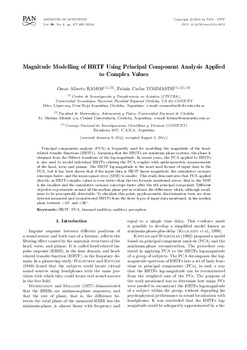| dc.contributor.author | Ramos, Oscar Alberto | |
| dc.contributor.author | Tommasini, Fabián Carlos | |
| dc.date.accessioned | 2021-10-18T14:05:19Z | |
| dc.date.available | 2021-10-18T14:05:19Z | |
| dc.date.issued | 2014 | |
| dc.identifier.citation | Ramos, O. A. y Tommasini, F. C. (2014). Magnitude modelling of HRTF using principal component analysis applied to complex values. Archives of Acoustics, 39 (4), 447-482. http://dx.doi.org/10.2478/aoa-2014-0051 | es |
| dc.identifier.uri | http://hdl.handle.net/11086/20831 | |
| dc.identifier.uri | http://dx.doi.org/10.2478/aoa-2014-0051 | |
| dc.description.abstract | Principal components analysis (PCA) is frequently used for modelling the magnitude of the head related transfer functions (HRTFs). Assuming that the HRTFs are minimum phase systems, the phase is obtained from the Hilbert transform of the log-magnitude. In recent years, the PCA applied to HRTFs is also used to model individual HRTFs relating the PCA weights with anthropometric measurements of the head, torso and pinnae. The HRTF log-magnitude is the most used format of input data to the PCA, but it has been shown that if the input data is HRTF linear magnitude, the cumulative variance converges faster, and the mean square error (MSE) is smaller. This study demonstrates that PCA applied directly on HRTF complex values is even better than the two formats mentioned above, that is, the MSE is the smallest and the cumulative variance converges faster after the 8th principal component. Different objective experiments around all the median plane put in evidence the differences which, although small, seem to be perceptually detectable. To elucidate this point, psychoacoustic discrimination tests are done between measured and reconstructed HRTFs from the three types of input data mentioned, in the median plane between −45◦ and +90◦. | en |
| dc.description.uri | http://acoustics.ippt.pan.pl/index.php/aa/article/view/294 | |
| dc.format.medium | Impreso; Electrónico y/o Digital | |
| dc.language.iso | eng | es |
| dc.rights | Attribution-NonCommercial-NoDerivatives 4.0 International | * |
| dc.rights.uri | http://creativecommons.org/licenses/by-nc-nd/4.0/ | * |
| dc.source | ISSN 0137-5075 | |
| dc.subject | HRTF | en |
| dc.subject | PCA | en |
| dc.subject | Binaural audition | en |
| dc.subject | Auditory perception | en |
| dc.title | Magnitude modelling of HRTF using principal component analysis applied to complex values | en |
| dc.type | article | es |
| dc.description.version | publishedVersion | es |
| dc.description.fil | Fil: Ramos, Oscar Alberto. Consejo Nacional de Investigaciones Científicas y Técnicas. Centro de Investigación y Transferencia en Acústica; Argentina. | es |
| dc.description.fil | Fil: Ramos, Oscar Alberto. Universidad Tecnológica Nacional. Facultad Regional Córdoba. Centro de Investigación y Transferencia en Acústica; Argentina. | es |
| dc.description.fil | Fil: Ramos, Oscar Alberto. Consejo Nacional de Investigaciones Científicas y Técnicas; Argentina. | es |
| dc.description.fil | Fil: Tommasini, Fabián Carlos. Consejo Nacional de Investigaciones Científicas y Técnicas. Centro de Investigación y Transferencia en Acústica; Argentina. | es |
| dc.description.fil | Fil: Tommasini, Fabián Carlos. Universidad Tecnológica Nacional. Facultad Regional Córdoba. Centro de Investigación y Transferencia en Acústica; Argentina. | es |
| dc.description.fil | Fil: Tommasini, Fabián Carlos. Universidad Nacional de Córdoba. Facultad de Matemática, Astronomía y Física; Argentina. | es |
| dc.description.fil | Fil: Tommasini, Fabián Carlos. Consejo Nacional de Investigaciones Científicas y Técnicas; Argentina. | |
| dc.journal.city | Varsovia | es |
| dc.journal.country | Polonia | es |
| dc.journal.editorial | Polish Academy of Sciences & Institute of Fundamental Technological Research | en |
| dc.journal.number | 4 | es |
| dc.journal.pagination | 447-482 | es |
| dc.journal.referato | Con referato | |
| dc.journal.title | Archives of Acoustics | es |
| dc.journal.volume | 39 | es |
| dc.description.field | Otras Ingenierías y Tecnologías | |





